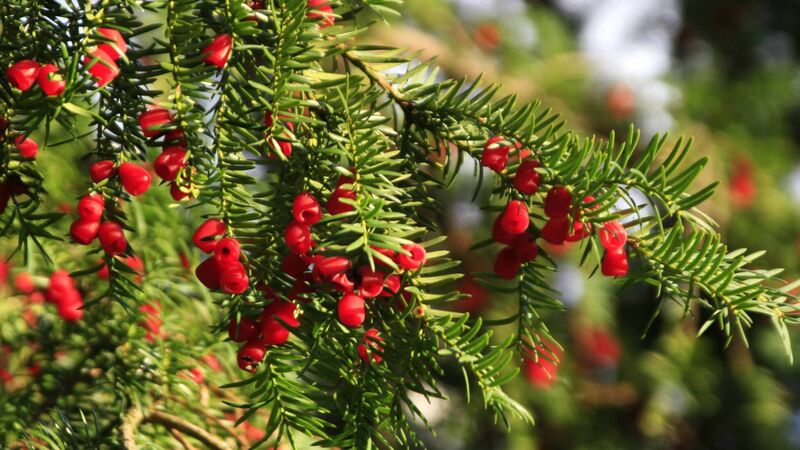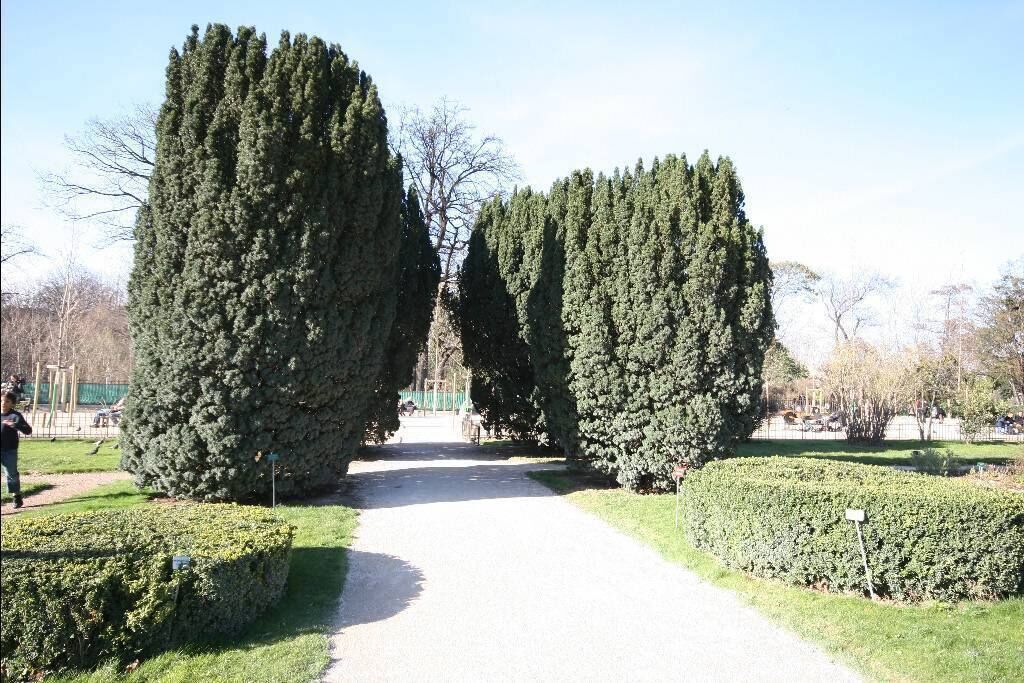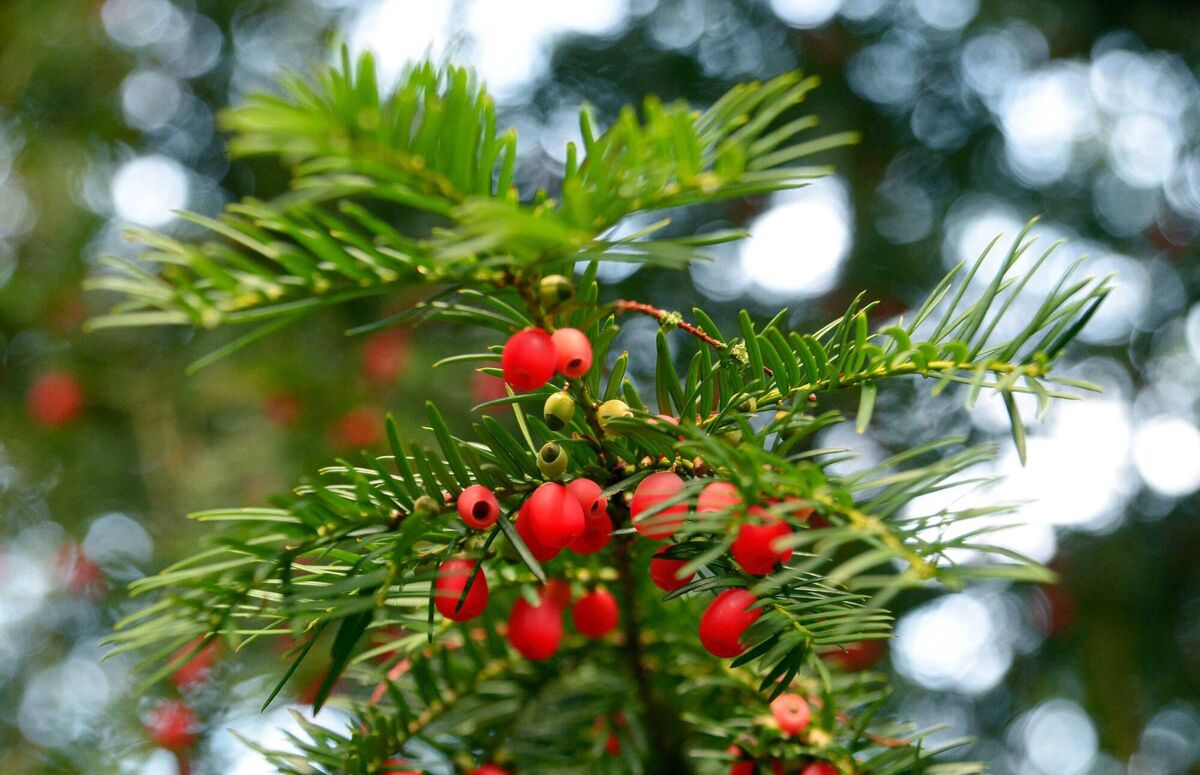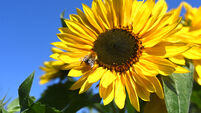Deadly yew — used in witch's potions and to deter cattle from graveyards

The seeds of yew berries are poisonous. Fortunately for the enthusiastic song thrushes, blackbirds, waxwings and robins that feast on yew berries, neither their beaks not their stomach muscles are strong enough to crack open of break down the seed, allowing it to pass through the bird undamaged, with no ill effects
Yew berries are ripe right now.
The berries are the only part of the yew tree that is not poisonous — but the large seeds that are concealed inside the berries are poisonous so its best not to take any risks by eating the berries.
The berries only develop on female yew trees, a sweet fleshy lure that invites birds to gobble them up and inadvertently transport the seeds inside. Fortunately for the enthusiastic song thrushes, blackbirds, waxwings and robins who feast on yew berries, neither their beaks nor their stomach muscles are strong enough to crack open or break down the seed, allowing it to pass through the bird undamaged, with no ill effects.
Children should be taught to consider yew trees and their tempting red berries as poisonous.
The poisonous compounds are not limited to the seeds. Lethal alkaloids known as taxines are present in all parts of the yew tree, except for the red fleshy part of the fruit. Shakespeare describes the Third Witch in brewing a poisonous concoction in her cauldron: “Gall of goat, and slips of yew; slivered in the moon’s eclipse”.
Today, these same poisons, initially extracted from the bark of Pacific yew trees, are produced synthetically for use in a range of chemotherapy cancer treatments.
Yew’s lethal nature is likely one of the reasons why these trees have long been venerated in folklore and mythology. The fact that they live for hundreds or even thousands of years is another reason why yew trees have always been revered. To us, with our relatively short lifespans, yew trees appear to never die. The Fortinghall Yew in Scotland and the Llangernyw Yew in Wales are both reputed to be between 4,000 and 5,000 years of age.

Yew is one of only three native evergreen tree species; that they retain their foliage year-round would also have set them apart from the annual cycle of dormancy and renewal that all other native trees go through. This apparent immortality was seen as a sacred quality. Druids are reputed to have considered Yew trees as keepers of the threshold between life and death, or the boundary between this world and other, mysterious, spirit realms. Yew trees were associated with protection.
These characteristics and beliefs are the basis of the practice of planting yew trees in church grounds and graveyards. The early Christian church here would have been keen to incorporate old pre-Christian beliefs in to the Christian faith. As result, there is barely a church or a graveyard today without yew trees.
But there is alternative, much more pragmatic, explanation. It is only relatively recently that much of the Irish landscape was enclosed into hedge-bound fields. Church grounds might have been among the few pieces of land in each parish that cattle couldn’t wander into, so the grass inside was likely luscious and appealing to anyone tempted by a parcel of free grazing. But cows and horses browsing on the foliage of yew trees will die from the poison therein, so planting a few yew trees was a sure way for the Church authorities to deter anyone considering letting their cattle trespass on church grounds to graze.
Aside from churchyards, Yew trees are relatively rare in Ireland today, especially wild ones. The presence in post-glacial pollen records and prevalence in placenames, however, indicates that yew trees were once widespread throughout the island of Ireland. Irish names for Yew include Iúr and Eó. Mayo is anglicised from ‘Maigh Eó’ which translates as ‘The Plain of the Yew’; Terenure in Dublin comes from ‘Tír an Iúr’, ‘Land of the Yew’; Newry from an tIúr after a yew tree that St Patrick reputedly planted there; and Youghal comes from Eochaill, a yew wood.

Yew grows best in well-drained, lime-rich soils, which also happen to be especially suited as agricultural land. Thus, yew was one of the tree species which suffered most as a result of large-scale woodland clearance for the creation of agricultural land during the Bronze-Age. Now, Reenadinna wood in Killarney National Park is the only substantial remaining Yew woodland in Ireland, and also has the accolade of being the largest area of yew woodland in Western Europe, at 25 hectares. This is an exceptional place, having developed perhaps 5,000 years ago on a limestone outcrop, it has been continually covered with Yew trees ever since.
Because yew woods are now so rare, Reenadinna is legally protected as priority habitat under the European Habitats Directive. The woods are paved with limestone underfoot, lusciously carpeted in moss-covered limestone boulders, with yew trees richly draped with lichens.
Wild yew trees are widespread across the Burren in County Clare, where yew woodland is considered to be the potential natural vegetation of the limestone landscapes. Sadly, the feral goats that are abundant in the Burren browse upon yew with relish, seemingly immune to the toxins, and this prevents wild trees there from ever growing to a decent size.
A variant of native Yew is known as ‘Irish yew’, which, due to a genetic mutation, grows as a more upright, compact and columnar tree than is normal for yew trees. Two unusual looking seedlings were observed growing in the limestone uplands where west Cavan borders Fermanagh, by a tree enthusiast named George Willis in 1767. The saplings were dug up and transplanted to the nearby Florencecourt Estate and one of these became known as the distinctive Florencecourt Yew. Now, more than 280 years later, cuttings from this very tree are growing in graveyards, landscaped gardens and demesnes all over Ireland and Britain, each ‘Irish Yew’ propagated from the original ‘Mother’ of all Irish Yews, still growing at Florencecourt in Fermanagh.








